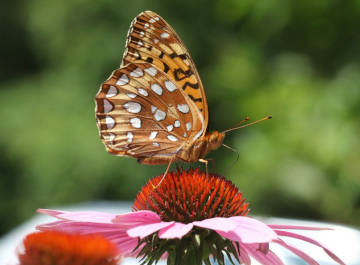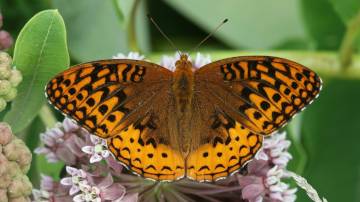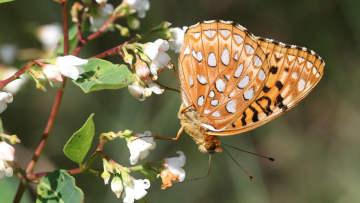Nature Notes

PHOTO COURTESY OF GARRY KESSLER
The great spangled fritillary gets its name from its silvery spangles.
July 21, 2022
NATURE NOTES
By Annie Reid
Westborough Community Land Trust
Spangled butterflies in local fields and gardens
July is one of our best months for spotting “flowers that fly,” as poet Robert Frost famously described butterflies. Have you noticed another large orange butterfly, besides the iconic monarch? Great spangled fritillaries are large and picturesque like monarchs, but they live more local lives, without the monarch’s storied long-distance migration.
Named for the showy silver spots – the spangles – on the underside of their wings, great spangled fritillaries (Speyeria cybele) start flying rapidly over fields and gardens in June, but they haven’t traveled from farther south to get here, as our early-season monarchs have done. Instead, they live all their life stages locally.

PHOTO COURTESY OF GARRY KESSLER
The great spanged fritillary looks orange in flight due to the orange and brown topside of its wings.
You can see the spangles when a great spangled fritillary nectars at a flower, such as purple coneflower, milkweed, joe-pye weed, or butterfly bush. This butterfly looks orange in flight due to the orange and brown pattern on the topside of its wings, which span about three inches.
Like monarchs and many other butterflies, great spangled fritillaries visit milkweed plants for nectar, but they don’t use milkweed as host plants for their eggs and caterpillars, as monarchs do. Instead, great spangled fritillaries depend on wild violets as their host plants.
Yet when violets bloom in May, you won’t see great spangled fritillary butterflies around them. At that time of year, our great spangled fritillaries are caterpillars. In this early life stage, they feed on new shoots and leaves of violets. The caterpillars do their munching at night, when there’s less danger from hungry birds and predatory wasps, so you’re unlikely to find them.
As the caterpillars eat and grow, they shed their old skin six times. At the same time, grasses and weeds grow up around the violets in fields and woodlands, hiding these plants from our view. In June, the caterpillars enter another stage, with each forming a brown-and-black chrysalis around itself and starting a 2-3-week metamorphosis into a butterfly.

PHOTO COURTESY OF GARRY KESSLER
A great spanged fritillary caterpillar, well nourished by violet leaves and armed with spines to avoid being eaten.
The great spangled fritillary butterflies that you see in early summer are males. They start looking for females, which emerge later, in mid- to late summer. After the two find each other and mate, the females typically hold off on laying eggs until late summer. Then they lay eggs near violets, but not usually on them.
What happens next might seem puzzling. The eggs hatch in early fall, and the very tiny caterpillars crawl to nearby violets. But do they start eating? No, they go dormant until May, when they revive and begin feeding on violets.
Why avoid eating until spring? The answer may have to do with winter survival. While the fritillary caterpillars lie dormant in leaf litter in winter, any bits of food inside their bodies could trigger the formation of damaging ice crystals. Great spangled fritillaries and their fritillary relatives, as a group, have northerly ranges, and not eating in fall may help their caterpillars get through frigid winters.
What might a warming climate mean for great spangled fritillaries? So far, so good, but time will tell. The great spangled fritillary appears not to have declined in Massachusetts in recent decades. The same cannot be said for two smaller fritillaries (also spangled), the aphrodite fritillary (Speyeria aphrodite) and the atlantis fritillary (Speyeria atlantis). Both have become less common, especially in eastern Massachusetts. There’s a concern that wild violets may not fare well in a warming climate.

PHOTO COURTESY OF GARRY KESSLER
The aphrodite fritillary is less common in eastern Massachusetts.
Long-term, loss of habitat is a risk to great spangled fritillaries. Adult butterflies need flowers with nectar. For their caterpillars, fritillaries need environments that are good for wild violets, meaning woods and fields that might get mowed but not plowed. Such lands often end up as shopping centers or housing developments.
Keep your eye out for great spangled fritillaries this summer, as well as other butterflies. Will this be a good year for them? The size of butterfly populations can vary considerably from year to year, so we’ll find out later.